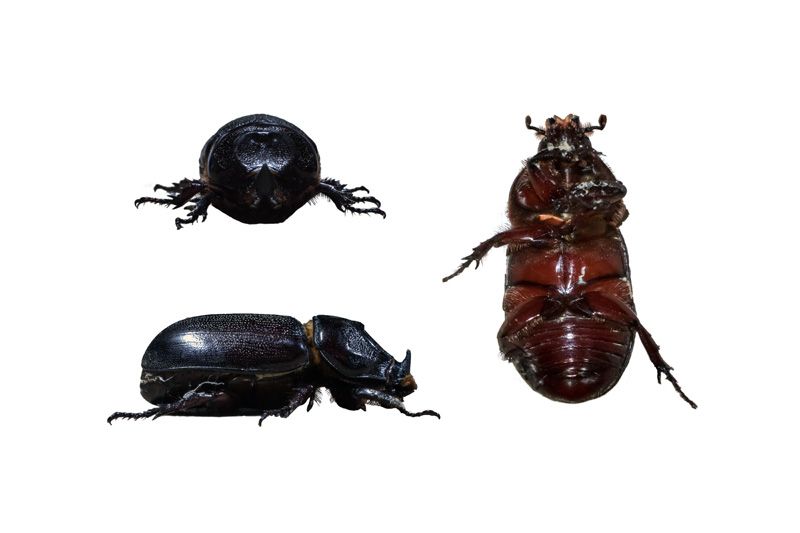
Coconut rhinoceros Beetle – Asiastic rhinoceros Beetle –
Coconut rhinoceros Beetle – Asiastic rhinoceros Beetle
Description of Insect:
The coconut rhinoceros beetle (Oryctes rhinoceros), also known as the Asiatic rhinoceros beetle, is a large beetle native to tropical Asia. Renowned for its striking appearance, the adult beetle is dark brown to black, measuring between 30-50 mm in length. It features a characteristic horn-like structure on its head, more prominent in males than females. This horn gives the beetle its “rhinoceros” title.
These beetles possess reddish-brown hairs on the ventral surface of the body, which are grouped together on the abdomen in females. The larvae are C-shaped, milky-white grubs with red heads, that pass through three developmental instars. Adult beetles are nocturnal and highly destructive to coconut palms and other palm species. They feed by boring into the crowns of the palms, damaging the young tissues, and feeding on the sap.
The damaged fronds show prominent V-shaped cuts or holes through the midrib. Larvae of the coconut rhinoceros beetle thrive in decomposing organic matter, such as compost, dead palm trunks, and manure. These grubs do not directly harm plants but are vital to the species’ life cycle.
Life cycle of Coconut rhinoceros Beetle
The life cycle of the coconut rhinoceros beetle consists of four stages: egg, larva, pupa, and adult. Females lay eggs in decaying organic matter, such as rotting logs, mulch, or manure piles. Each female can produce 50-100 eggs over her lifespan. These eggs are oval, cream-colored, and hatch within 8-12 days.
The larval stage is the longest phase, lasting 11 to 15 weeks depending on environmental conditions. During this time, the grubs feed on decomposing material, growing up to 100 mm in length. Fully grown larvae pupate within the organic matter, transitioning into the pupal stage, and becoming immobile for 6 weeks.
After pupation, adult beetles emerge and become active, living for 4-9 months. Adults fly to new trees, feed, and mate shortly after emergence, completing the life cycle. Since it thrives in tropical regions without cold or dry seasons, the beetles can reproduce year-round.
Damage they cause:
The coconut rhinoceros beetle is one of the most damaging pests of coconut and palm trees. Its impact poses a significant threat to tropical and subtropical regions where palms are a vital resource.
- Agricultural Impact: The beetle primarily targets coconut palms, oil palms, and other ornamental palms. Adults bore into the crowns of palm trees to feed on the sap of young, developing fronds. This feeding results in stunted growth, reduced fruit production, secondary infections, and even tree death. Coconut and oil palm plantations, critical to local economies, suffer substantial yield losses due to beetle damage.
- Economic Impact: The coconut rhinoceros beetle poses a significant economic threat, particularly to industries reliant on palm trees. In regions where coconut and oil palm cultivation are major economic drivers, beetle infestations lead to reduced yields, and increased costs of quarantine and control.
- Ecological Impact: Beyond agriculture, the coconut rhinoceros beetle disrupts native ecosystems by attacking native palm species and other coastal plants. This pest has invaded islands and coastal areas, where it threatens the natural balance of palm-dominated landscapes. In areas where palms are integral to biodiversity, the beetle’s presence can negatively impact species that rely on palms for food or shelter.
